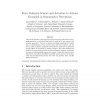118
Voted
AIPS
2011
14 years 4 months ago
2011
Consider the task of a mobile robot autonomously navigating through an environment while detecting and mapping objects of interest using a noisy object detector. The robot must re...
95
Voted
CONNECTION
2006
15 years 15 days ago
2006
This article describes a developmental system based on information theory implemented on a real robot that learns a model of its own sensory and actuator apparatus. There is no in...
86
Voted
NIPS
2003
15 years 1 months ago
2003
We present a novel connectionist model for acquiring the semantics of a simple language through the behavioral experiences of a real robot. We focus on the “compositionality” ...
108
Voted
ISER
1995
Springer
15 years 4 months ago
1995
Springer
We review the current state of research in autonomous mobile robots and conclude that there is an inadequate basis for predicting the reliability and behavior of robots operating ...
99
Voted
ICRA
1995
IEEE
15 years 4 months ago
1995
IEEE
This paper presents a method of vision-based reinforcement learning by which a robot learns to shoot a ball into a goal, and discusses several issues in applying the reinforcement...
111
click to vote
ROBOCUP
2000
Springer
15 years 4 months ago
2000
Springer
Q-learning, a most widely used reinforcement learning method, normally needs well-defined quantized state and action spaces to converge. This makes it difficult to be applied to re...
119
click to vote
VW
1998
Springer
15 years 4 months ago
1998
Springer
Abstract. This paper presents Webots: a realistic mobile robot simulator allowing a straightforward transfer to real robots. The simulator currently support the Khepera mobile robo...
138
click to vote
KES
1998
Springer
15 years 4 months ago
1998
Springer
An agent must acquire internal representation appropriate for its task, environment, sensors. As a learning algorithm, reinforcement learning is often utilized to acquire the rela...
113
Voted
GECCO
2003
Springer
15 years 5 months ago
2003
Springer
We describe the first instance of an approach for control programming of humanoid robots, based on evolution as the main adaptation mechanism. In an attempt to overcome some of th...
CEC
2003
IEEE
15 years 5 months ago
2003
IEEE
We introduce a technique that allows a real robot to execute real-time learning, in which GP and RL are integrated. In our former research, we showed the result of an experiment wi...



